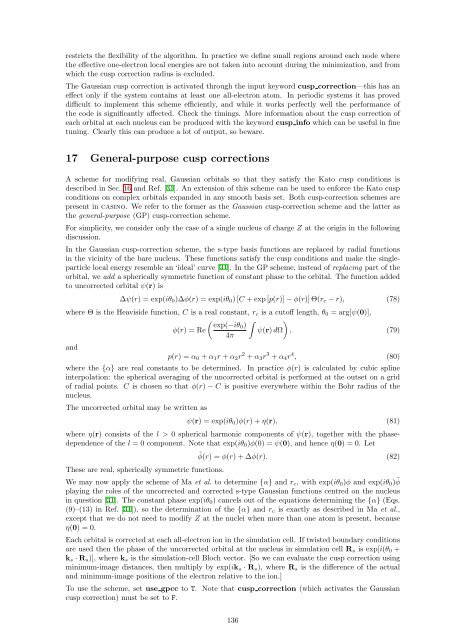CASINO manual - Theory of Condensed Matter
CASINO manual - Theory of Condensed Matter
CASINO manual - Theory of Condensed Matter
Create successful ePaper yourself
Turn your PDF publications into a flip-book with our unique Google optimized e-Paper software.
estricts the flexibility <strong>of</strong> the algorithm. In practice we define small regions around each node where<br />
the effective one-electron local energies are not taken into account during the minimization, and from<br />
which the cusp correction radius is excluded.<br />
The Gaussian cusp correction is activated through the input keyword cusp correction—this has an<br />
effect only if the system contains at least one all-electron atom. In periodic systems it has proved<br />
difficult to implement this scheme efficiently, and while it works perfectly well the performance <strong>of</strong><br />
the code is significantly affected. Check the timings. More information about the cusp correction <strong>of</strong><br />
each orbital at each nucleus can be produced with the keyword cusp info which can be useful in fine<br />
tuning. Clearly this can produce a lot <strong>of</strong> output, so beware.<br />
17 General-purpose cusp corrections<br />
A scheme for modifying real, Gaussian orbitals so that they satisfy the Kato cusp conditions is<br />
described in Sec. 16 and Ref. [31]. An extension <strong>of</strong> this scheme can be used to enforce the Kato cusp<br />
conditions on complex orbitals expanded in any smooth basis set. Both cusp-correction schemes are<br />
present in casino. We refer to the former as the Gaussian cusp-correction scheme and the latter as<br />
the general-purpose (GP) cusp-correction scheme.<br />
For simplicity, we consider only the case <strong>of</strong> a single nucleus <strong>of</strong> charge Z at the origin in the following<br />
discussion.<br />
In the Gaussian cusp-correction scheme, the s-type basis functions are replaced by radial functions<br />
in the vicinity <strong>of</strong> the bare nucleus. These functions satisfy the cusp conditions and make the singleparticle<br />
local energy resemble an ‘ideal’ curve [31]. In the GP scheme, instead <strong>of</strong> replacing part <strong>of</strong> the<br />
orbital, we add a spherically symmetric function <strong>of</strong> constant phase to the orbital. The function added<br />
to uncorrected orbital ψ(r) is<br />
∆ψ(r) = exp(iθ 0 )∆φ(r) = exp(iθ 0 ) [C + exp [p(r)] − φ(r)] Θ(r c − r), (78)<br />
where Θ is the Heaviside function, C is a real constant, r c is a cut<strong>of</strong>f length, θ 0 = arg[ψ(0)],<br />
( ∫ )<br />
exp(−iθ0 )<br />
φ(r) = Re<br />
ψ(r) dΩ , (79)<br />
4π<br />
and<br />
p(r) = α 0 + α 1 r + α 2 r 2 + α 3 r 3 + α 4 r 4 , (80)<br />
where the {α} are real constants to be determined. In practice φ(r) is calculated by cubic spline<br />
interpolation: the spherical averaging <strong>of</strong> the uncorrected orbital is performed at the outset on a grid<br />
<strong>of</strong> radial points. C is chosen so that φ(r) − C is positive everywhere within the Bohr radius <strong>of</strong> the<br />
nucleus.<br />
The uncorrected orbital may be written as<br />
ψ(r) = exp(iθ 0 )φ(r) + η(r), (81)<br />
where η(r) consists <strong>of</strong> the l > 0 spherical harmonic components <strong>of</strong> ψ(r), together with the phasedependence<br />
<strong>of</strong> the l = 0 component. Note that exp(iθ 0 )φ(0) = ψ(0), and hence η(0) = 0. Let<br />
These are real, spherically symmetric functions.<br />
˜φ(r) = φ(r) + ∆φ(r). (82)<br />
We may now apply the scheme <strong>of</strong> Ma et al. to determine {α} and r c , with exp(iθ 0 )φ and exp(iθ 0 ) ˜φ<br />
playing the roles <strong>of</strong> the uncorrected and corrected s-type Gaussian functions centred on the nucleus<br />
in question [31]. The constant phase exp(iθ 0 ) cancels out <strong>of</strong> the equations determining the {α} (Eqs.<br />
(9)–(13) in Ref. [31]), so the determination <strong>of</strong> the {α} and r c is exactly as described in Ma et al.,<br />
except that we do not need to modify Z at the nuclei when more than one atom is present, because<br />
η(0) = 0.<br />
Each orbital is corrected at each all-electron ion in the simulation cell. If twisted boundary conditions<br />
are used then the phase <strong>of</strong> the uncorrected orbital at the nucleus in simulation cell R s is exp[i(θ 0 +<br />
k s · R s )], where k s is the simulation-cell Bloch vector. [So we can evaluate the cusp correction using<br />
minimum-image distances, then multiply by exp(ik s · R s ), where R s is the difference <strong>of</strong> the actual<br />
and minimum-image positions <strong>of</strong> the electron relative to the ion.]<br />
To use the scheme, set use gpcc to T. Note that cusp correction (which activates the Gaussian<br />
cusp correction) must be set to F.<br />
136

















